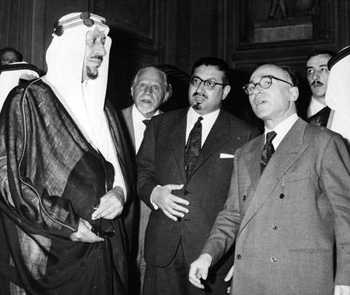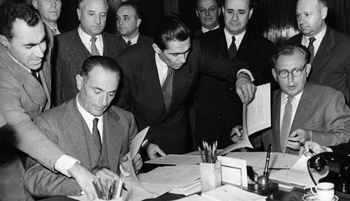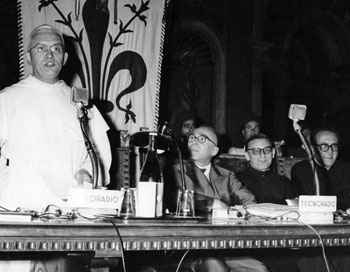Socio-Political Issues
 |
 |
 |
 |
 |
 |
 |
La Pira: A Catholic Communist - Part VIII
Helping Communist Interests at Vatican II
When considering the proposed canonization of La Pira, we need to continually ask ourselves: What is the elevated cause for which La Pira truly dedicated his life?
The smell worsens around the canonization process when we consider the following evidence of his complicity in Enrico Mattei’s corrupt business practices and how he used his position as Mayor of Florence to boost the business interests of Mattei who was close to all the key figures in the Italian government. It will become evident that the not-so-elevated cause of power politics was the motivating force in his friendship with Enrico Mattei.
 La Pira’s supporters affirm: “The friendship between La Pira and Mattei was always close, from the latter’s intervention in favor of the Pignone to their action in common with regard to the countries on the southern shore of the Mediterranean.”
La Pira’s supporters affirm: “The friendship between La Pira and Mattei was always close, from the latter’s intervention in favor of the Pignone to their action in common with regard to the countries on the southern shore of the Mediterranean.”
The background to the friendship is interesting. Under cover of his “Mediterranean Conferences,” La Pira acted as an unofficial emissary of the Italian government to pave the way for ENI’s lucrative deals with the oil-producing countries, Morocco, Tunisia, Algeria and the Middle East. He initiated “diplomatic” contacts with rulers such as Sultan Mohammed V of Morocco and President Nasser of Egypt whose trade deals helped make ENI one of the largest oil companies in the world.
It comes as no surprise to find that the first Mediterranean Conference (October 1958) was financed by Mattei and enthusiastically supported by Mgr Montini. (1) Both stood to gain: Mattei won contracts for exploration and production rights in the relevant Mediterranean countries, and Montini advanced his “integral humanism” towards a new theology, a new “civilization of love” and eventually a new liturgy for a new Church.
The Algerian Revolution
While La Pira was hypocritically engaged in his diplomatic parleys – allegedly for the purposes of “peace and harmony among the Mediterranean nations” – he demonstrated his support for the revolutionaries who were violently overthrowing French rule in Algeria. He authorized the presence at his 1958 Conference of one of the leaders of the anti-colonial movement, Ahmed Boumendjel, a high official in the terrorist organization, the National Liberation Front. This caused a diplomatic incident between Italy and France which was heightened by the discovery that Mattei was fomenting hostilities and endorsing terrorism by financing the rebellion.
Both La Pira and Mattei saw the anti-colonial movement through commercial lenses: it was, for Italy, a politically advantageous way of exploiting the Algerian oil fields and its natural gas reserves while taking them away from the French.
To help Mattei to build his own empire and extend state power is bad enough, but to further enrich a magnate who was already one of the best remunerated businessmen in the public sector is another example of La Pira’s hypocrisy. It clashes with his preaching about the necessity for “evangelical poverty.”
Economic dialogue with the communists
 Similarly, La Pira’s 1959 visit to the Soviet Union was productive for Mattei, who brokered an agreement with Khrushchev for the supply of crude oil and natural gas to ENI.
Similarly, La Pira’s 1959 visit to the Soviet Union was productive for Mattei, who brokered an agreement with Khrushchev for the supply of crude oil and natural gas to ENI.
We can conclude that the real “Bridge between East and West” that La Pira was referring to was commercial and his “fraternal cooperation” was also economic, as evidenced in the construction of a gas pipeline extending from Russia to Italy to deliver fuel to ENI. (Click here for a photo of the gas pipeline or so-called “bridge” of fraternity being constructed between the two nations.)
The socialist basis of Vatican-Moscow relations
At the beginning of this series it was shown that La Pira was the link between the Kremlin and the Vatican to procure the non-condemnation of Communism at Vatican II. Now we can see the incontrovertible evidence that the whole idea of communist participation in the Council and the “thaw” in Vatican-Kremlin relations had been initiated by La Pira and discussed with the Russian Ambassador to Italy, Semyen Kozyrev, as early as 1960.
 Recently published declassified documents from the State Archives of the Russian Federation show the central role played by La Pira. (2) They include a transcript of his conversation taken from the Kozyrev’s diary, dated July 27, 1962 – i.e. a month before the infamous Pact of Metz – in which La Pira guaranteed the support of Pope John XXIII for a communist presence at the Council. (3) On that occasion, he also assured Kozyrev that no criticism or hostile comments would be made about the Soviet Bloc countries. (4)
Recently published declassified documents from the State Archives of the Russian Federation show the central role played by La Pira. (2) They include a transcript of his conversation taken from the Kozyrev’s diary, dated July 27, 1962 – i.e. a month before the infamous Pact of Metz – in which La Pira guaranteed the support of Pope John XXIII for a communist presence at the Council. (3) On that occasion, he also assured Kozyrev that no criticism or hostile comments would be made about the Soviet Bloc countries. (4)
The same archival source uncovers the basis of the Russian-Vatican accord. No condemnation of the USSR could be made for the following reason: Alexei Kosygin, President Gronchi and Enrico Mattei had pledged to forge a massive deal over the supply of crude oil and gas to Italy that would not only boost the Soviet economy but break the hegemony of the privately owned multi-national oil companies, particularly those of the USA, in the global market. (5)
La Pira’s ideal of “breaking down walls and building bridges” was mentioned in the documents and accepted by Kozyrev as an euphemism for the politically motivated deal. (6)
When Cardinal Tisserant and the Metropolitan Nikodim signed the Pact of Metz, they were really only ratifying a political deal which had been initiated by La Pira, sealed by the representatives of the USSR and Italy, Kozyrev and Kosygin, Prime Minister Fanfani, President Gronchi and Enrico Mattei, and blessed by Pope John XXIII to the great satisfaction of Msgr. Montini, the future Pope Paul VI.
Continued

Posted July 12, 2013
The smell worsens around the canonization process when we consider the following evidence of his complicity in Enrico Mattei’s corrupt business practices and how he used his position as Mayor of Florence to boost the business interests of Mattei who was close to all the key figures in the Italian government. It will become evident that the not-so-elevated cause of power politics was the motivating force in his friendship with Enrico Mattei.

La Pira worked for ENI on his Mideast ‘pilgrimages,’ above, with the Saudi Arabian King in 1962
The background to the friendship is interesting. Under cover of his “Mediterranean Conferences,” La Pira acted as an unofficial emissary of the Italian government to pave the way for ENI’s lucrative deals with the oil-producing countries, Morocco, Tunisia, Algeria and the Middle East. He initiated “diplomatic” contacts with rulers such as Sultan Mohammed V of Morocco and President Nasser of Egypt whose trade deals helped make ENI one of the largest oil companies in the world.
It comes as no surprise to find that the first Mediterranean Conference (October 1958) was financed by Mattei and enthusiastically supported by Mgr Montini. (1) Both stood to gain: Mattei won contracts for exploration and production rights in the relevant Mediterranean countries, and Montini advanced his “integral humanism” towards a new theology, a new “civilization of love” and eventually a new liturgy for a new Church.
The Algerian Revolution
While La Pira was hypocritically engaged in his diplomatic parleys – allegedly for the purposes of “peace and harmony among the Mediterranean nations” – he demonstrated his support for the revolutionaries who were violently overthrowing French rule in Algeria. He authorized the presence at his 1958 Conference of one of the leaders of the anti-colonial movement, Ahmed Boumendjel, a high official in the terrorist organization, the National Liberation Front. This caused a diplomatic incident between Italy and France which was heightened by the discovery that Mattei was fomenting hostilities and endorsing terrorism by financing the rebellion.
Both La Pira and Mattei saw the anti-colonial movement through commercial lenses: it was, for Italy, a politically advantageous way of exploiting the Algerian oil fields and its natural gas reserves while taking them away from the French.
To help Mattei to build his own empire and extend state power is bad enough, but to further enrich a magnate who was already one of the best remunerated businessmen in the public sector is another example of La Pira’s hypocrisy. It clashes with his preaching about the necessity for “evangelical poverty.”
Economic dialogue with the communists

Mattei, left, signs an oil agreement with Russia in 1962
We can conclude that the real “Bridge between East and West” that La Pira was referring to was commercial and his “fraternal cooperation” was also economic, as evidenced in the construction of a gas pipeline extending from Russia to Italy to deliver fuel to ENI. (Click here for a photo of the gas pipeline or so-called “bridge” of fraternity being constructed between the two nations.)
The socialist basis of Vatican-Moscow relations
At the beginning of this series it was shown that La Pira was the link between the Kremlin and the Vatican to procure the non-condemnation of Communism at Vatican II. Now we can see the incontrovertible evidence that the whole idea of communist participation in the Council and the “thaw” in Vatican-Kremlin relations had been initiated by La Pira and discussed with the Russian Ambassador to Italy, Semyen Kozyrev, as early as 1960.

La Pira, second to left, at a prepatory conference for the Council. To his right is Card. Danielou
The same archival source uncovers the basis of the Russian-Vatican accord. No condemnation of the USSR could be made for the following reason: Alexei Kosygin, President Gronchi and Enrico Mattei had pledged to forge a massive deal over the supply of crude oil and gas to Italy that would not only boost the Soviet economy but break the hegemony of the privately owned multi-national oil companies, particularly those of the USA, in the global market. (5)
La Pira’s ideal of “breaking down walls and building bridges” was mentioned in the documents and accepted by Kozyrev as an euphemism for the politically motivated deal. (6)
When Cardinal Tisserant and the Metropolitan Nikodim signed the Pact of Metz, they were really only ratifying a political deal which had been initiated by La Pira, sealed by the representatives of the USSR and Italy, Kozyrev and Kosygin, Prime Minister Fanfani, President Gronchi and Enrico Mattei, and blessed by Pope John XXIII to the great satisfaction of Msgr. Montini, the future Pope Paul VI.
Continued
- Pietro Domenico Giovanni, ‘Dalla «civiltà cristiana» alle «civiltà teologali» Note su Giorgio La Pira e le Genesi dei Colloqui mediterranei’, in Alessandro Cortesi (Ed.), Europa e Mediterraneo, Nerbini, Florence, 2008, p. 165
- See Pietro Neglie, La Stagione del Disgelo: Il Vaticano, l'Unione Sovietica e la politica di centro-sinistra in Italia (1958-1963), Cantagalli, 2010
- In response to La Pira’s proposition as spokesman for the then Prime Minister, Amintore Fanfani, Kozyrev commented: “L' idea fondamentale di Fanfani resta la possibilità di una intermediazione fra Oriente e Occidente, in primo luogo fra Urss e Usa. L' Italia, secondo Fanfani, deve diventare un ponte fra i due campi. Papa Giovanni è a conoscenza di tali aspirazioni di Fanfani e le approva” [The fundamental idea of Fanfani is the possibility of mediation between East and West, principally between the USSR and the USA. Italy, according to Fanfani, should become the bridge between the two blocks. Pope John is aware of Fanfani’s aspirations and approves them].
In fact, La Pira was known among the Soviets as “vicinissimo al Papa” - very close to the Pope: (ibid., p. 133) - These are the words of Kozyrev: “La Pira mi ha fatto capire chiaramente che la parte italiana mette in relazione ... la visita di Kruscev con il successo del Concilio” and “non vi sarà alcun affondo contro i Paesi socialisti.” [La Pira let me understand clearly that the Italians link ... the visit of Khrushchev with the success of the Council] (ibid., p. 171)
- In a transcript of the negotiations between Kosygin and Mattei, the latter is recorded as saying that he wanted to eliminate competition from the major oil producers: “Alleggerire la presenza in Europa e in Africa delle grandi compagnie internazionali del mercato petrolifero che fanno parte del Cartello come Standard Oil, British Petroleum, Shell [To diminish the presence in Europe and Africa of the great international oil companies that belong to the cartel, such as Standard Oil, British Petroleum, Shell].” (ibid., pp. 161-2)
- Ibid., p. 170

Posted July 12, 2013
______________________
______________________











